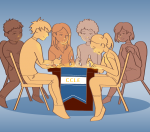If you’re a classics major with a thing for good old-fashioned Roman discourse, the forums of UCLA’s Common Collaboration and Learning Environment might seem like a familiar and effective means of communication.
Everyone else in the current millennium, however, would likely appreciate an update to our online collaborative tools.
CCLE integrates well with students’ classes, automatically giving them access to a plethora of benefits. These include allowing professors to push out mass messages, post content categorized per UCLA’s 10-week quarter system and enable students to submit assignments electronically.
But the platform falls flat in one of its titular goals: collaboration. Though the site does contain a feature that technically serves that purpose by allowing students to create discussion forums, the interface is clunky, dated – with an origin story set in ’90s – and rarely used.
But, online communication has improved since the 20th century. Social media sites have become much more prevalent and user-friendly, with older forum-style interfaces being eclipsed by more fluid, multimedia-friendly designs. Forums just aren’t used as frequently today. Social tools live and die by the size of their user base, and UCLA’s current tools really don’t have the level of participation needed to be useful.
The CCLE interface isn’t up to becoming a communication hub. On the instructor side, there’s an intimidating matrix of group settings for discussion threads that, while affording a fine degree of control, can act as a barrier. On the student side, the forum structure isn’t flexible enough to meet various student needs. A system based on more familiar social media design patterns, such as actual groups, likes and follows, would be easier to use and fulfill the goal of fostering collaboration online at UCLA.
There are many modern features CCLE would need to add to be an effective means of collaboration. Like with social media, a group formation feature could help students find relevant content more quickly. A feature such as being able to comment on posts, as opposed to adding to a cluttered string of replies, could help delineate different kinds of content from one other.
Existing third-party social media has already been shown to enhance the college experience. In a report by the Babson Survey Research Group, YouTube has seen widespread use in classrooms. The group also cited Facebook as being heavily used in contexts related to faculty professions, meaning an interface like Facebook would be familiar and more readily usable by instructors.
A separate study from the Research in Higher Education Journal analyzed several different dissertations about the use of social media as instructional tools, and found only two of 29 brought up negative impacts of the technology.
Social media use in education clearly seems to be sticking. After all, it allows instructors to share multimedia content and interact with students in more places and in a more efficient manner.
But commercial social media alone won’t cut it. Respondents to the Babson Survey Research Group survey cited concerns with ensuring privacy and student integrity on social media. This is where an in-house tool can help. CCLE is already tied to a student’s multifactor-authenticated MyUCLA account, which could help with integrity issues. It also has no financial incentive to sell student data for advertising revenue, as do larger social media companies. Additionally, being tied into CCLE could allow for easier collaboration between students within a class, and active instructor participation.
There are also open technical standards that can ensure CCLE serves its role as a collaboration hub while using social media-inspired, easy-to-use designs. ActivityPub, as an example, became a formal recommendation by the World Wide Web Consortium, a standards body for internet-related technology, in January. The standard defines a format for social media content, and a communication protocol that allows different social media platforms to talk to each other. This means a platform that adopts this standard could resemble popular social media platforms such as Twitter, while integrating well with other adherent platforms, such as the video hosting platform Peertube.
This would give students the freedom to exchange information with many other platforms, while keeping the service under control of, and integrated with, UCLA.
Of course, some professors have adopted existing collaboration services to fill the gap. Piazza is one such service, providing more focus on discussions, allowing instructors and students alike to create threads, and sending out email notifications when students’ questions receive responses. However, the format lacks the categorization and file-sharing features of CCLE. Piazza also poses some privacy concerns, as it is an entity separate from the university. It also heavily promotes its job-searching service with pop-ups, distracting from the main allure of the service: collaborative learning.
The forum was a center for learning and discussion in classical times. In our time, the internet forum is a dead format and CCLE’s offerings don’t adequately serve student needs. Modern social media platforms are more familiar and are better designed for student communication.
It’s time for CCLE to burn bridges and cross the Rubicon into the current decade.
